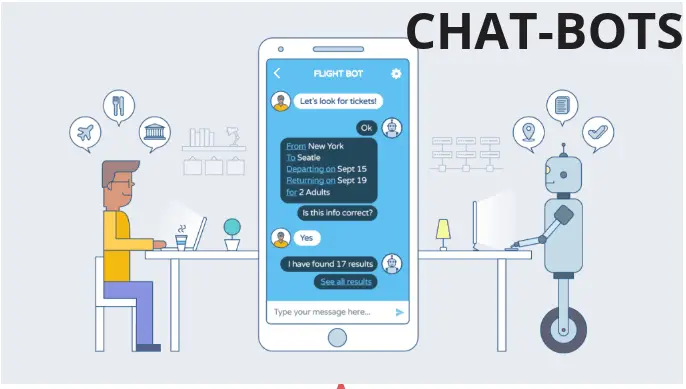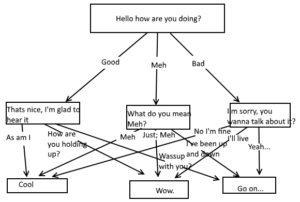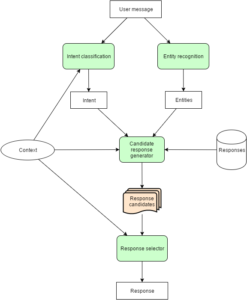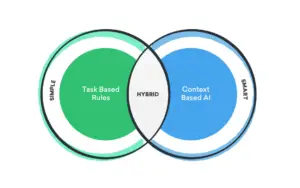Introduction
In this article, we will take you through different types of chatbots that are popular in the industry right now. We will explain to you their architecture, how they work, and some examples from the industry use cases. But before diving deep into the details, let us first understand what is chatbot in the first place.
What is Chatbot?

Chatbot are messaging software that carry out human like converstaions with users who visit website and mobile apps to provide information and assistance to them. Chatbots have become a hot market because they stay active 24×7 to interact with users. Their usecases include lead generation, marketing, virtual assistance, and much more.
Types Of Chatbots
There can be different ways to categorize types of chatbots based on their industry (e.g. healthcare, banking) or purpose (e.g. virtual assistance, lead generation) or by technical architecture.
In this post, we will focus on the technical architecture to define following types of chatbots-
- Rule Based Chatbot
- AI-NLP Based Chatbot
- Hybrid Chatbot
1. Rule Based Chatbot
Architecture
As the name suggest, rule-based chatbots are governed by predefined rules and flow of conversation. Such chatbots usually offer menu driven interface to the users and control the flow of conversation. When the user selects an option, either displays the next set of sub menu or searches its knowledge base to produce the result back to the user.
If the menu choices do not match what users are looking for, then the good chatbot design should give option to connect to a human assistant on the chatbot interface only or by email or phone.

Limitations
Such chatbots however have no artificial intelligence and are limited by the rules that are designed by its developers. So you must have quite a specific usecases in mind to design the flow of conversation before hand and cannot be used for general use cases. But the rules become quite complex as they keep on growing and hence they cannot be scaled easily.
Also due to menu driven conversation, such chatbots do not give a feel of human like conversation to the users.
Usecases
Rule-based chatbots are the most common chatbots that are widely used in services business websites to offer support and information. They are also quite suited to build interactive FAQ for the users.
Overall this type of chatbot is quite common in industries like food ordering, ticket booking, hotel booking, banking, e-commerce.
2. AI-NLP Based Chatbot
Architecture
AI based chatbots are powered by machine learning and natural language processing. This type of chatbots are trained to have a free flowing conversation with the users and hence show a more human-like behaviour.
When a user give a free text as input, the chatbot parses the sentence and tries to understand the intent of the user and the entity involved in the conversation. It then replies accordingly with the answer as per its pretrained model or by looking for the answer from its knowledge base.
If the chatbot is unable to identify the intent of the user then it may also redirect the conversation to actual human assistance if needed.

To understand why AI based chatbots are so powerful, we need to realize that the user may give input for its same intent in many ways. For example, the user asks to “book Uber for office“. This can be expressed in other ways like “book a Uber for me to get to office”, “book me a Uber to office”, etc.
The entities involved here Uber and Office, and the intent here is Booking a Cab from Uber. The AI based chatbot can understand entities from all the variation in the user input and classify the intent as “booking cab”. It then goes to book Uber by using some APIs.
Limitations
Even though AI based chatbots may look quite cool, they cannot be always perfect. They may end up misunderstaning the intent of the user and give undesired responses. Such goof ups can be costly if the chatbot is intented for critical support, pre sales enquiry, lead generations, etc.
Usecases
AI based chatbots are common in virtual assistants like Amazon Alexa, Apple Siri, Google Assistants. However, they are not used in customer services or support industry directly due to the limitations that we discussed above.
3. Hybrid Chatbot
Architecture
Such types of chatbots are a combination of Rule based chatbots and AI based chatbots that we discussed above. Both these chatbots had certain disadvantages but hybrid chatbots take the best from these two and produce a very robuts chatbot solution.
Hybrid chatbots are designed to do small talks with the users using its pretrained NLP model, and also identify its intent to answer smaller queries. But the critical support and informations are provided using the rule based design to ensures there are no mistakes by the chatbot.

Usecases
Since hybrid chatbots inherit the best of both rule based and AI based chatbots, its potential usecases are pretty much in all industries. They can be used for virtual assistance, marketing, customer support, lead generation, etc.
-
I am Saurabh Vaishya, an Engineering Student currently learning and exploring the world of AI and ML. A combination of software and hardware to create a miracle is what I love the most.
View all posts


